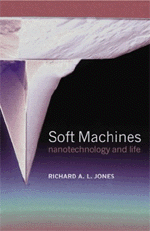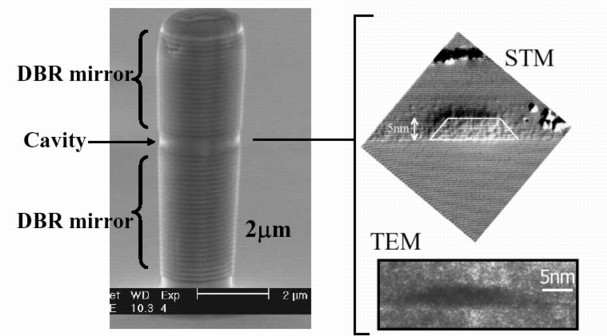The current edition of “Physics World” carries a letter from K. Eric Drexler, written in response to my article in the August edition, “The future of nanotechnology“. There is also a response from me to Drexler’s letter. Since the letters section of Physics World is not published online, I reproduce the letters here. The text here is as the authors wrote them; they’ve been lightly edited to conform with Physics World house style in the printed version.
From Dr K.Eric Drexler to Physics World.
I applaud Physics World for drawing attention to the emerging field of artificial molecular machine systems. Their enormous productive potential is illustrated in biology and nature, where we observe molecular machine systems constructing molecular machinery, electronics, and digital information storage systems at rates measured in billions of tons per year. To understand the future potential of fabrication technologies (the foundation of all physical technology) we must examine the productive potential of artificial molecular machine systems. This field of enquiry has been a focus of my research since (Drexler 1981), which explored directions first suggested by (Feynman 1959).
I was surprised to find that Professor Richard Jones, in describing ���flaws in Drexler���s vision,��� ignores my physical analysis of productive molecular machine systems. He instead criticizes the implied hydrodynamics of an artist���s fantastic conception of a ���nanosubmarine��� ��� a conception not based on my work. It is, I think, important that scientific criticisms address the scientific literature, not artistic fantasies.
Professor Jones then offers a discussion of nanoscale surface forces, thermal motion, and friction that could easily leave readers with the impression that these present dire problems, which he implies have been ignored. But ignoring surface forces or thermal motion in molecular engineering would be like ignoring gravity or air in aeronautics, and physical analysis shows that well-designed molecular bearing interfaces can have friction coefficients far lower than those in conventional machines. These issues (and many others) are analyzed in depth, using the methods of applied physics, in Chapters 3, 5, and 10 of my book Nanosystems (Drexler 1992). Professor Jones fails to cite this work, noting instead only my earlier, popular book written for a general audience.
I agree with Professor Jones regarding the importance of molecular machine systems and the value of learning from and imitating biological systems at this stage of the development of our field. Where we part company is in our judgment of the future potential of the field, of the feasibility of molecular machine systems that are as far from the biological model as a jet aircraft is from a bird, or a telescope is from an eye. I invite your readers to examine the physical analysis that supports this understanding of non-biological productive molecular machine systems, and to disregard the myths that have sprung up around it. (One persistent myth bizarrely equates productive molecular machines with gooey nanomonsters, and then declares these to be impossible contraptions that grab and juggle atoms using fat, sticky fingers.)
There are many interesting research questions to address and technology thresholds to cross before we arrive at advanced artificial molecular machine systems. The sooner we focus on the real physics and engineering issues, building on the published literature, the sooner progress can be made. To focus on artist���s conceptions and myths does a disservice to the community.
K. Eric Drexler, PhD
Molecular Engineering Research Institute
K E Drexler 1981 Molecular Engineering: An approach to the development of general capabilities for molecular manipulation. Proc. Nat. Acad. Sci. (USA) 78:5275���5278
K E Drexler 1992 Nanosystems: Molecular Machinery, Manufacturing, and Computation (New York Wiley/Interscience)
R Feynman 1959 There���s Plenty of Room at the Bottom, in D Gilbert (ed) 1961 Miniaturization (New York Reinhold)
From Dr Richard A.L. Jones to Physics World.
I am pleased that Dr Drexler finds so much to agree with in my article. Our goals are the same; our research aims to understand how to make molecular scale machines and devices. Where we differ is how best to achieve that goal. The article was necessarily very brief in its discussion of surface forces, friction and thermal motion, and my book [1] contains a much fuller discussion, which does explicitly refer to Drexler���s book ���Nanosystems���. No-one who has read ���Nanosystems��� could imagine that Drexler is unaware of these problems, and it was not my intention in the article to imply that he was. Absurd images like the nanosubmarine illustration I used are widely circulated in popular writings about Drexlerian nanotechnology; they well illustrate the point that na?�ve extrapolations of macro-scale engineering to the nanoscale won���t work, but I���m happy to agree that Drexler���s own views are considerably more sophisticated than this. The point I was making was that the approach Drexler describes in detail in Nanosystems, (which he himself describes in the words: ���molecular manufacturing applies the principles of mechanical engineering to chemistry���), works within a paradigm established in macroscopic engineering and seeks to find ways to engineer around the special features of the nanoworld. In contrast to this, the design principles adopted by cell biology turn these special features to advantage and actively exploit them, using concepts such as self-assembly and molecular shape change that have no analogue in macroscopic engineering. Again, Dr Drexler and I are in agreement that in the short term biomimetic nanotechnology will be very fruitful and should be strongly pursued. We differ about the likely long term trajectory of the technology, but here, experiment will decide. Such is the unpredictable nature of the development of technology that I rather suspect that the outcome will surprise us both.
[1] Soft Machines, R.A.L. Jones, OUP (2004)

